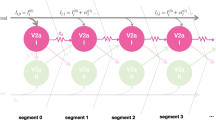Abstract.
Most previous models of the spinal central pattern generator (CPG) underlying locomotion in the lamprey have relied on reciprocal inhibition between the left and right side for oscillations to be produced. Here, we have explored the consequences of using self-oscillatory hemisegments. Within a single hemisegment, the oscillations are produced by a network of recurrently coupled excitatory neurons (E neurons) that by themselves are not oscillatory but when coupled together through N-methyl-d-aspartate (NMDA) and α-amino-3-hydroxy-5-methyl-4-isoxazolepropionicacid (AMPA)/kainate transmission can produce oscillations. The bursting mechanism relies on intracellular accumulation of calcium that activates Ca2+-dependent K+. The intracellular calcium is modeled by two different intracellular calcium pools, one of which represents the calcium entry following the action potential, CaAP pool, and the other represents the calcium inflow through the NMDA channels, CaNMDA pool. The Ca2+-dependent K+ activated by these two calcium pools are referred to as KCaAP and KCaNMDA, respectively, and their relative conductances are modulated and increase with the background activation of the network. When changing the background stimulation, the bursting activity in this network can be made to cover a frequency range of 0.5–5.5 Hz with reasonable burst proportions if the adaptation is modulated with the activity. When a chain of such hemisegments are coupled together, a phase lag along the chain can be produced. The local oscillations as well as the phase lag is dependent on the axonal conduction delay as well as the types of excitatory coupling that are assumed, i.e. AMPA/kainate and/or NMDA. When the caudal excitatory projections are extended further than the rostral ones, and assumed to be of approximately equal strength, this kind of network is capable of reproducing several experimental observations such as those occurring during strychnine blockade of the left-right reciprocal inhibition. Addition of reciprocally coupled inhibitory neurons in such a network gives rise to antiphasic activity between the left and right side, but not necessarily to any change of the frequency if the burst proportion of the hemisegmental bursts is well below 50%. Prolongation of the C neuron projection in the rostrocaudal direction restricts the phase lag produced by only the excitatory hemisegmental network by locking together the interburst intervals at different levels of the spinal cord.
Similar content being viewed by others
Author information
Authors and Affiliations
Additional information
Received: 29 September 1998 Accepted in Revised Form: 26 March 1999
Rights and permissions
About this article
Cite this article
Kotaleski, J., Lansner, A. & Grillner, S. Neural mechanisms potentially contributing to the intersegmental phase lag in lamprey . Biol Cybern 81, 299–315 (1999). https://doi.org/10.1007/s004220050564
Issue Date:
DOI: https://doi.org/10.1007/s004220050564




